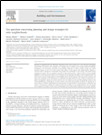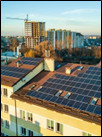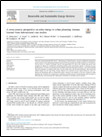How to integrate active and passive solar strategies in New and Existing Solar Neighborhoods?
This map works as a platform for the case studies collection related to the Subtask D "Case studies" within the IEA SHC Task 63 "Solar Neighborhood Planning“ and the Subtask C "Case studies and action research" within the IEA SHC Task 51 "Solar Energy in Urban Planning“.
In the map all the analyzed case studies are marked according to the different environments. For each case study a dedicated brochure (.pdf file) describing the case study in detail can be downloaded by the users.
Click on the top left icon for the navigation menu or click on the top right icon to view the map full screen with menu. To access all functions, open the map in the full
screen mode (indicated in the top right corner
 Ten questions concerning planning and design strategies for solar neighborhoods
Ten questions concerning planning and design strategies for solar neighborhoods
Building and Environment, Volume 246, 2023, 110946, ISSN 0360-1323,
Authors: Mattia Manni, Matteo Formolli, Alessia Boccalatte, Silvia Croce, Gilles Desthieux, Caroline Hachem-Vermette, Jouri Kanters, Christophe Ménézo, Mark Snow, Martin Thebault, Maria Wall, Gabriele Lobaccaro.
The paper presents a definition of solar neighborhood, outlining its key characteristics. Through a review of active and passive solar strategies, the challenges and barriers in the solar neighborhood are addressed. Planning and design strategies based on case studies for solar neighborhoods are presented. Holistic approach addressing competing urban surface uses and their impacts. Legislative agenda and emerging trends in solar neighborhood planning and design.
 From the definition of the Solar Neighborhood to illustrative worldwide exemplary case studies of solar energy planning
From the definition of the Solar Neighborhood to illustrative worldwide exemplary case studies of solar energy planning
Presentation at Seminar Solenergi i stadsplanering / Solar Neighborhood Planning
May 2024 - Gamla Biskopshuset, Biskopsgatan 1, Lund (Sweden)
By: Mattia Manni, Gabriele Lobaccaro
The presentation provides the definition of the Solar Neighborhood and illustrates some of the worldwide exemplary case studies where both solar passive and active energy strategies have been deployed.
 Solar Neighborhood Planning: Optimize Solar Energy Use in Cities Through the Digitalization of the Built Environment
Solar Neighborhood Planning: Optimize Solar Energy Use in Cities Through the Digitalization of the Built Environment
Special Issue in Frontiers in Built Environment, Sustainable Design and Construction ,2024
Editors: Gilles Desthieux, Gabriele Lobaccaro, Mattia Manni, Silvia Croce, Caroline Hachem-Vermette, Martin Thebault, Jouri Kanters
The main goal of the research topic of this special issue is to support developers, property owners/associations, architects, urban planners, municipalities, institutions, and other key players to achieve solar neighborhoods that support long-term solar access for energy production and for daylighting buildings and outdoor environments – resulting in sustainable and healthy environments.
 A cross-country perspective on solar energy in urban planning: Lessons learned from international case studies
A cross-country perspective on solar energy in urban planning: Lessons learned from international case studies
Renewable and Sustainable Energy Reviews, Volume 108, 2019, Pages 209-237, ISSN 1364-0321
Authors: Gabriele Lobaccaro, Silvia Croce, Carmel Margaret Lindkvist, Maria Cristina Munari-Probst, Alessandra Scognamiglio, Johan Dahlberg, Marja Lundgren, Maria Wall.
This work, framed in the IEA SHC Task 51 “Solar Energy in Urban Planning”, presents an illustrative perspective of solar energy in urban planning through the analysis of 34 international case studies conducted in 10 countries. The aim here is to examine challenges, barriers and opportunities for active solar systems and passive solar strategies by taking into consideration interrelated technical and non-technical aspects in ongoing and completed projects. It focuses on exposing potential pitfalls and illustrating lessons learned in case studies divided into three categories: (i) existing urban areas, (ii) new urban areas, and (iii) solar landscapes.